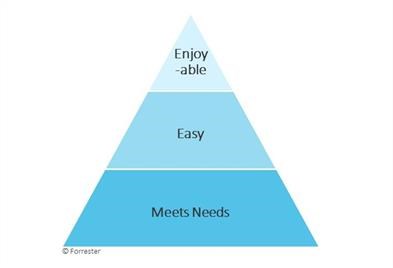In digital marketing, we often use the word “experience” to describe how we interact with customers, but we rarely define what “experience” means. According to Pine II and Gilmore, an experience occurs when a company intentionally uses services as the stage, and goods as props, to engage individual customers in a way that creates a memorable event (Harvard Business Review, 1998.) Experience is practical contact with observation of facts or events. In marketing, experience is the ongoing feeling or emotion evoked when someone interacts with your brand.
For brands, experience can be the differentiator between repeat business or a bad Google review. Experience, according to Qualtrics, a software company, is the new battleground for identifying market gaps and winning customers and creating breakthroughs. Thinking of brand experience from this point of view is disrupting the way individuals interact with products and services and elevating consumer expectations to a whole new level.
Welcome to the Customer Experience Economy
This concept of the “Customer Experience Economy,” where customers are driving how brands curate and solicit goods and services, originated in the early 1990s. The aforementioned Joe Pine II is best known for articulating this concept during a class he was teaching to an IBM Consulting Group in Palisades, New York in late 1993 or early 1994.
As any economist will tell you, mass customizing a good coupled with low costs, high volume and efficient operations equates a service. It was during one of these teaching moments when Pine further explained that “mass customization automatically turns a service into an experience” (Pine II & Gilmore, 2013). And voilà, the Experience Economy was born; superseding the Industrial Economy and Agrarian Economy.
In today’s day and age, Customer Experience is where a brand can live or die in a matter of minutes, thanks mostly to social media. If you’re not doing a good job managing the touchpoints of your product or service that encompass experience, you’re about to get bypassed by a brand that is.
The best example of this is the transformation of the ridesharing industry. Think back to the taxi industry, which has not evolved since the 1940s. The experience of riding in a taxi is very archaic, with a plexiglass window separating the passengers from the driver, making passengers feel more like criminals than patrons; a cash or credit card exchange within the vehicle, with many taxi drivers only accepting cash (an increasingly outdated method of payment in our digital world); and oftentimes an expensive fare with no real explanation of the cost.
It’s no surprise that when Uber and Lyft entered the scene with mobile apps, real-time driver tracking technology, a driver/passenger rating system, and the elimination of cash exchanges, this Customer Experience-centric business completely transformed the ridesharing industry. The reason this model is more effective is because it minimizes wait times, offers efficient up-to-date payment transactions, and provides real-time driver and passenger ratings (Ajmal, 2018).
Not to mention it re-humanizes the experience, and passengers are no longer alienated for sitting in the front seat during a rideshare — in fact, it’s encouraged. Despite the higher rates in some cities across the United States, Uber and Lyft are winning consumers and capturing more of the ridesharing marketplace because of their focus on customer experience.
The CX Hierarchy of Needs
Customer Experience (CX) has several variables that contribute to the differentiators that are driving this gap in the marketplace. According to research conducted by Forrester, there is a hierarchy of three things that make an experience worthwhile. That is: enjoyable, easy, and meets needs.

This hierarchy is similar to Masclow’s Hierarchy of Needs in which each level graduates to a higher level of need. But instead of human life satisfaction, this new hierarchy refers to customer satisfaction, and each level must be satisfied to impact the CX of the product or service.
Brands must pay careful attention to each level if they want to be competitive and expand retention rates and loyalty among a customer base. Making an experience enjoyable and easy can be difficult as customer expectations can be fragmented and unrealistic. Brands that strategically emphasize listening and implement customer feedback will easily work through this hierarchy to match what they’re providing with what their customers need.
From CRM to CXM: Management is Key
In the marketing world, large emphasis is placed on the CRM (Customer Relationship Management) including how leads are nurtured and cultivated from one end of the funnel to final conversion. With the emergence of CX, that concept has evolved into CXM (Customer Experience Management), the processes a company uses to manage every interaction with a customer and the brand throughout the customer journey or lifecycle.
One brand that continually thrives in the CXM space is Southwest Airlines. In a podcast produced by Ratelt, Sonya Lacor, Southwest’s VP of Inflight Operations, explains what Southwest Airlines does differently that sets them apart. According to Lacor, one of the keys to CXM is caring about the staff so they can pass that on to your customers through positive reinforcement and recognition.

“Southwest has ‘Culture Committees’ in the organization and we use ‘hokey ways’ such as playing cornhole at lunch, to have fun and come together as a team,” Lacor says of the organization’s work to improve employee satisfaction.
This type of enthusiasm and employee buy-in is then translated into the work when employees are looking to enhance the CX of passengers from one flight to another; building the brand from the inside out.
Another key takeaway from Southwest is spending time with front-line staff on a regular basis to help empower the staff to make decisions and take ownership of the work. And lastly, investing in internal communications and giving your folks an honest narrative is the key to keeping everyone on the same page (Customer Experience Leaders, 2019).
Listen to the full podcast episode here.
Whether you’re in the shoe business or real-estate, the Customer Experience Economy is here to stay. Brands that identify experience gaps within the marketplace will catapult to the top, just as Uber, Lyft, and Southwest Airlines have done. The only way to succeed in this marketplace is to marry CXM with internal processes that humanize a brand and build better experiences and relationships with employees and customers alike.
At LuckyTamm Digital Marketing, we focus on CX through our three-step process 1) plan it, 2) activate it, 3) evaluate it — as part of our client care protocol. We believe the CXM portion of our business is an extension of our core values and commitment to helping brands find new ways to connect with customers in a digital world.


